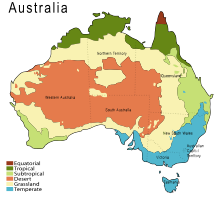This article needs additional citations for verification. (December 2012) |



The Australian environment ranges from virtually pristine Antarctic territory and rainforests to degraded industrial areas of major cities. Forty distinct ecoregions have been identified across the Australian mainland and islands. Central Australia has a very dry climate. The interior has a number of deserts while most of the coastal areas are populated. Northern Australia experiences tropical cyclones while much of the country is prone to periodic drought. This dry and warm environment and exposure to cyclones, makes Australia particularly vulnerable to climate change -- with some areas already experiencing increases in wildfires and fragile ecosystems.
The island ecology of Australia has led to a number of unique endemic plant and animal species, notably marsupials like the kangaroo and koala. Agriculture and mining are predominant land uses which cause negative impacts on many different ecosystems. The management of the impact on the environment from the mining industry, the protection of the Great Barrier Reef, forests and native animals are recurring issues of conservation.
The protected areas in Australia are important sources of ecotourism, with sites like the Great Barrier Reef and World Heritage sites like Tasmanian Wilderness World Heritage Area or the Uluṟu-Kata Tjuṯa National Park draw both national and international tourism. Clean Up Australia Day was an initiative developed in 1989 to collaboratively clean up local areas and is held on the first Sunday of autumn (in March).
In Australia forest cover is around 17% of the total land area, equivalent to 134,005,100 hectares (ha) of forest in 2020, up from 133,882,200 hectares (ha) in 1990. In 2020, naturally regenerating forest covered 131,614,800 hectares (ha) and planted forest covered 2,390,300 hectares (ha). Of the naturally regenerating forest 0% was reported to be primary forest (consisting of native tree species with no clearly visible indications of human activity) and around 18% of the forest area was found within protected areas. For the year 2015, 67% of the forest area was reported to be under public ownership, 32% private ownership and 1% with ownership listed as other or unknown. [1] [2]
- ^ Terms and Definitions FRA 2025 Forest Resources Assessment, Working Paper 194. Food and Agriculture Organization of the United Nations. 2023.
- ^ "Global Forest Resources Assessment 2020, Australia". Food Agriculture Organization of the United Nations.